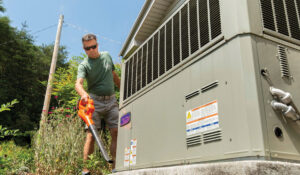In the 70s, the world was going through an energy crisis which led to long lines at gasoline stations and higher prices. Energy efficiency was foremost on consumer’s minds. Illinois Rural Electric News regularly carried columns to help consumers save on electricity costs and tips to keep appliances working best.
How to keep cool with electricity and keep your cooling costs down

We all should he concerned about using electricity wisely. The following is some helpful hints for this summer prepared by the Extension Division, Virginia Polytechnic Institute and State University—The Editors.
If your home has air conditioning, here are a few ways you can help keep your bills down without losing any of the cooling benefits.
Blinds — Keep the hot sun out. Draw your blinds, shades or draperies during the day, particularly on the sunny side of your home.
Insulation — Insulate your home. Even if you can’t get into the side walls, extra insulation in your attic will not only keep you cooler in the summer but also warmer in the winter.
Air—Take advantage of cooler air. When the outside temperature drops below the temperature inside your home—as in the evening— open your windows to let the inside heat escape.
Attics — Install an attic vent fan. The temperature in your attic can reach 140-160 degrees on a hot day. A small attic vent fan will exhaust the heat and keep it from radiating downward through your home.
Heat — Don’t add extra heat. Cut down on heat-producing uses inside the home, such as unnecessary cooking, ironing, lights, television sets, and radios that are on but not being used or watched.
Cooling — Don’t overcool. A five-degree change in your thermostat setting can mean a substantial decrease in your operating costs. Raise your setting to 76 degrees or 78 degrees as recommended by most air conditioning specialists.
Temperature — If you are a working family or plan to be away all day, raise the thermostat setting on
your air conditioner by five degrees when you leave.
Care — Have your central cooling unit serviced each year. An air conditioner that is out of adjustment can increase your operating costs while giving you very little cooling.
When major appliances get vacation

If you’re planning a couple of weeks of active vacation, it’s wise to give some thought to the “still life” of those automatic appliances that will be idle while you’re gone. Let common sense and good housekeeping be your guides.
Range—If you have a self-cleaning oven, take advantage of it. After dinner the evening before you leave, set the controls and let the oven clean itself while you perform last minute packing.
Refrigerators—Before leaving, clear the refrigerator of perishables. If you have a combination refrigerator-freezer, check those perishables to see if they can bestored in the freezer section for an excellent first meal or hearty snack upon your return home.
Food Freezer—Celebrate your homecoming before you ever start your vacation by stocking your freezer with food for the first major meal upon your return. This eliminates the need for an immediate trip to the market for first-meal fixings.
Dishwasher—If yours is a portable dishwasher, be sure the hoses are disconnected. Soiled dishes and silver should be cleaned before leaving. The short cycle on some dishwashers is ideal for doing last-minute odds and ends.
Washers and Dryers—Turn off your laundry faucets to relieve pressure on the hoses connected to your automatic washer. A dryer takes no special care but be sure all controls are turned off.








